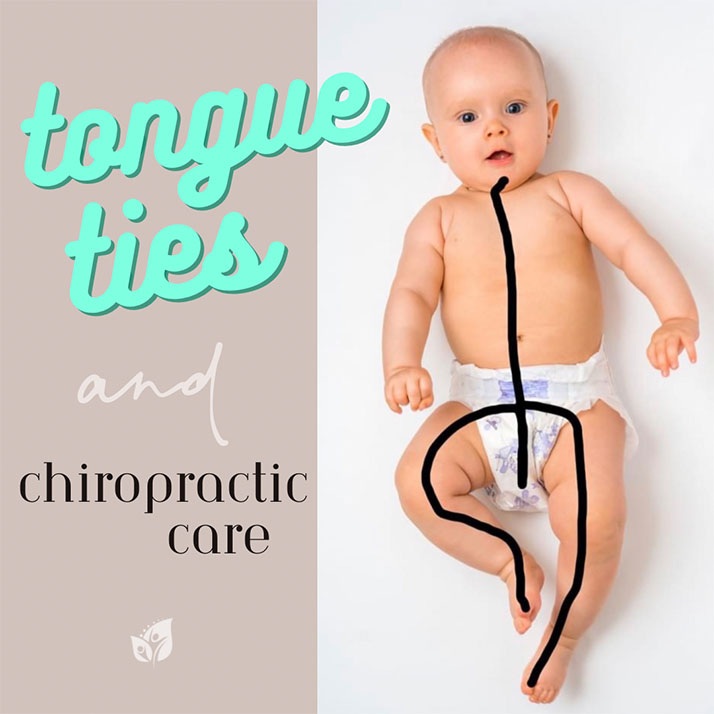Tongue Ties and Chiropractic Care in Mandeville LA
Tongue Ties and Chiropractic Care in Mandeville LA

"The tongue muscle and the swallowing muscles are attached to the bones of the head and neck. Proper structure = proper function!"
Tongue Ties: 4 Ways Chiropractic Can Help
These days, there’s controversy surrounding infant tongue tie surgery (“tongue tie” or “tethered oral tissue”). Also, it’s easy to assume that tethered oral tissue is causing the feeding problem—and that could be! But consider what other structures might be causing the problem. In clinical practice, I’ve seen tongue, head, or neck problems that affect feeding function.
You may be wondering, can the pediatric chiropractor help? The chiropractor cannot diagnose a tongue-tie. But they can do much to help the baby before and after a tongue tie surgery, if surgery is needed. The chiropractor might also be able to help your baby avoid a tongue tie surgery, altogether. If you suspect your child or practice member has a tongue tie, here are 4 points you should consider.
Reducing interference to tongue muscles in Mandeville LA
If your infant’s tongue seems tight, oral tissue (frenulum) might not be restricting it. In some cases, nerves that power the tongue may be up-regulated (increased power) or down-regulated (decreased power). Regardless, in either case, the tongue muscle can appear tight. Also, it can be possible that the genioglossus muscle has trigger points as well, thus pulling the frenulum to the floor of the mouth. Recent research has found a direct connection between the frenulum fascia and the genioglossus muscle.
When a tongue is tighter than normal, you may experience pain if you are breastfeeding. Your baby may also have trouble transferring milk from bottle or breast. Also, some babies have frequent spitting up due to an inability to completely swallow. Nevertheless, a tight or dysfunctional tongue muscle can cause feeding problems.
The chiropractor can fix this problem. He or she will make gentle adjustments to normalize the neck, intra-oral cranial bones and soft tissue. This removes the interference or cause of nerve up-regulation or down-regulation to the tongue. Up-regulation of the tongue is not always the case but should be ruled out or cared for to enhance breastfeeding function before pursuing other treatments.
Aligning bone and joint structures that are attached to the tongue
The tongue muscle and the swallowing muscles are attached to the bones of the head and neck.
However, if the bony structure is not aligned in the normal position, the soft tissues connected to those bony structures will be pulled and tugged from their normal position. Hence, this can restrict tongue motion and give the appearance of “posterior tongue tie”. Feeding difficulty will follow.
Having trouble visualizing how this works?
Try this: look down, tuck your chin to your chest and rotate your head to the right. Now, try to suck, swallow and breathe. I think you get my point. When your skull and neck moved away from normal alignment, your swallowing and breathing became difficult and less effective. The chiropractor can align and normalize these structures and their function to correct this adaptation. If you suspect a “tongue tie”, a trip to see the pediatric chiropractor won’t do any harm and might do a world of good.
Ruling out the frenum as the culprit
Perhaps everyone can see that the tongue is restricted. But the frenum isn’t always the culprit causing that restriction. The medical professional might not realize that the tongue is being restricted by another structure, for example, a tight lower jaw. If you are unclear what a tongue tie is, watch this 2-minute video!
Pediatric chiropractors have special training in recognizing structural issues—and in this case, the structural issue could be either soft tissue or bony tissue. Therefore, getting chiropractic care and oral soft tissue care before a tongue tie evaluation or surgery will allow the release provider to better assess the tongue’s natural state of being. It also helps the medical professional or lactation consultant to discern whether the tissue (frenum) is functional (doesn’t need tongue tie surgery) or not functional (needs tongue tie surgery).
Enhancing results of tongue tie surgery
Sometimes, tongue tie surgery is necessary. And, if so, “pre-habilitation” is considered a best practice method to ensure optimal results.
“Pre-habilitation” gives the doctor better “tissue” to work with. It also makes it easier to see inside the baby’s mouth. Before the surgery, it’s important to achieve alignment of the head and neck structures. If surgery is performed on a structure that is not in normal alignment, the wound may heal in an abnormal position and the problem may resurface in the future. Having correct alignment of anatomical structures prior to the surgery just makes sense, right? Surgery can be less effective on an area that is not structurally normal or sound.
Prior to surgery, a pediatric chiropractor can optimize head and neck structure and tongue function. Whether there is a structural problem in the head and neck or not, your baby will benefit from pre-surgical soft tissue care.
Post-surgery, the chiropractor can help to rehabilitate the head, spine, and tongue. This promotes:
- correct motor skill development of the tongue and spine
- encourages and supports correct wound healing
- helps the baby’s anatomy to accommodate the change created from the surgery.
By taking these steps, you will significantly decrease the chance of a surgical revision and optimize whatever surgery was just performed.
Monday
8:30am - 12:00pm
3:00pm - 6:00pm
Tuesday
3:00pm - 6:30pm
Wednesday
8:30am - 12:00pm
3:00pm - 6:00pm
Thursday
8:30am - 12:00pm
3:00pm - 6:30pm
Friday
8:30am - 12:00pm
Saturday & Sunday
Closed
Southern Family Chiropractic
2077 N Causeway Blvd Ste 3
Mandeville, LA 70471
P: (985) 778-2881
F: (985) 778-2886




